

#include <fem_adapt_algs.h>
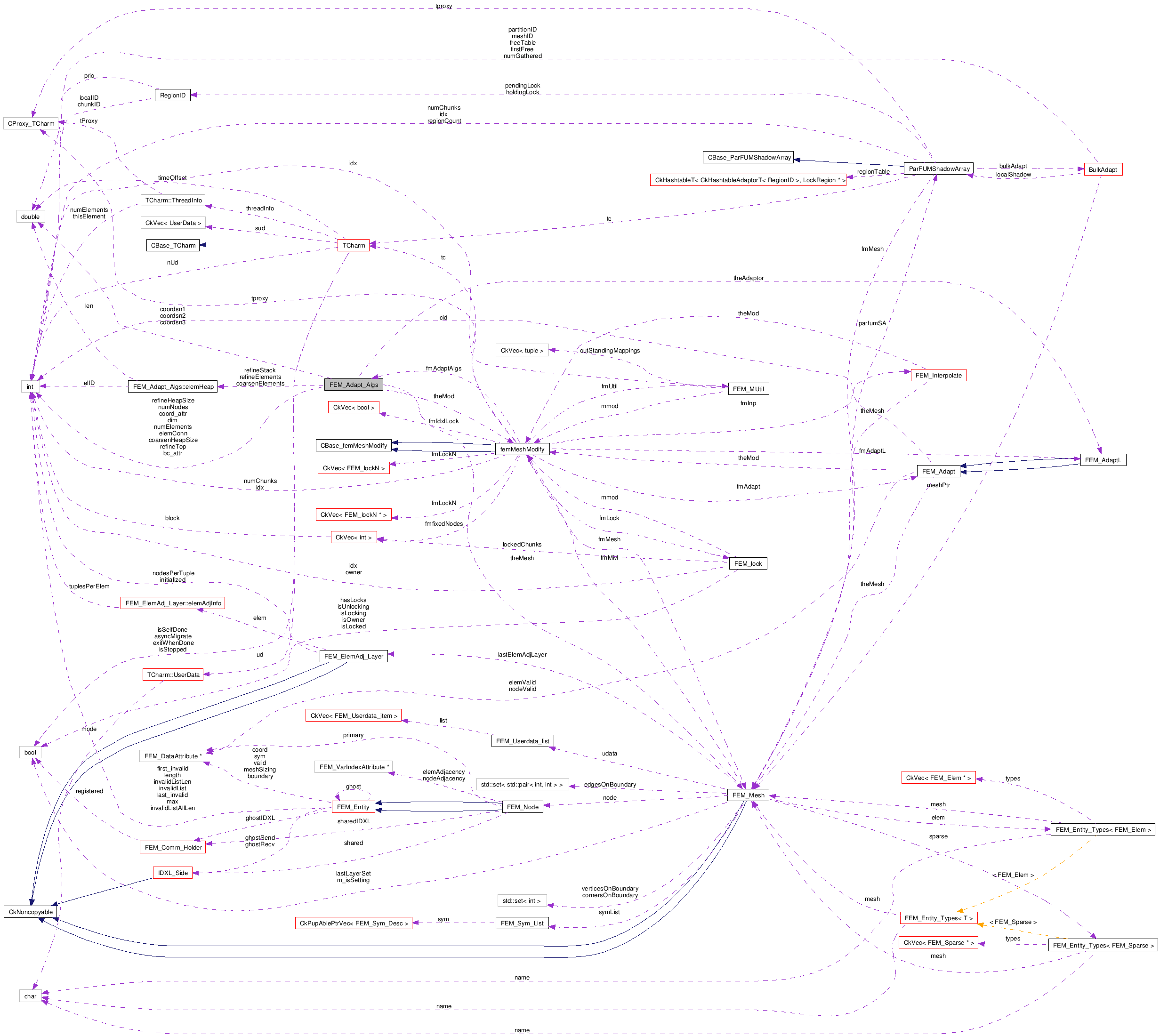
Public Member Functions | |
| FEM_Adapt_Algs () | |
| FEM_Adapt_Algs (FEM_Mesh *m, femMeshModify *fm, int dimension) | |
| Initialize FEM_Adapt_Algs with a chunk of the mesh. | |
| void | FEM_Adapt_Algs_Init (int coord_at, int bc_at) |
| void | FEM_Refine (int qm, int method, double factor, double *sizes) |
| Perform refinements on a mesh. | |
| void | FEM_Coarsen (int qm, int method, double factor, double *sizes) |
| Perform coarsening on a mesh. | |
| void | FEM_AdaptMesh (int qm, int method, double factor, double *sizes) |
| Perform refinement/coarsening on a mesh. | |
| void | FEM_Smooth (int qm, int method) |
| Smooth the mesh using method according to some quality measure qm. | |
| void | FEM_mesh_smooth (FEM_Mesh *meshP, int *nodes, int nNodes, int attrNo) |
| Repair the mesh according to some quality measure qm. | |
| void | FEM_Repair (int qm) |
| Elements with a bad quality metric are either flipped or coarsened to newer elements which are of better quality. | |
| void | FEM_Remesh (int qm, int method, double factor, double *sizes) |
| Remesh entire mesh. | |
| void | SetReferenceMesh () |
| Set sizes on mesh elements based on their average edge length. | |
| void | GradateMesh (double smoothness) |
| Adjust sizes on mesh elements to avoid sharp discontinuities. | |
| virtual int | refine_element_leb (int e) |
| Initiate instance of Longest Edge Bisection on an element. | |
| virtual void | refine_flip_element_leb (int e, int p, int n1, int n2, double le) |
| Continue longest edge bisection on element 'e', then flip edge (n1,n2); If the length of the new edge (p, newnode) is greater than 'le' (longest edge), recursively call this function on (newElem, p, n1, newNode, le). | |
| int | simple_refine (double targetA, double xmin=0.0, double ymin=0.0, double xmax=1.0, double ymax=1.0) |
| The region is defined by (xmax, xmin, ymax, ymin) and the target area is given by targetA. | |
| int | simple_coarsen (double targetA, double xmin=0.0, double ymin=0.0, double xmax=1.0, double ymax=1.0) |
| The region is defined by (xmax, xmin, ymax, ymin) and the target area is given by targetA. | |
| double | length (int n1, int n2) |
| double | getArea (int n1, int n2, int n3) |
| double | length (double *n1_coord, double *n2_coord) |
| double | getArea (double *n1_coord, double *n2_coord, double *n3_coord) |
| int | getCoord (int n1, double *crds) |
| int | getShortestEdge (int n1, int n2, int n3, int *shortestEdge) |
| double | getAreaQuality (int elem) |
| The quality metric is proportional to the area of the triangle upon the sum of squares of the lengths of each of the 3 sides. | |
| bool | didItFlip (int n1, int n2, int n3, double *n4_coord) |
| bool | didItFlip (double *n1_coord, double *n2_coord, double *n3_coord, double *n4_coord) |
| double | getSignedArea (double *n1_coord, double *n2_coord, double *n3_coord) |
| void | tests (void) |
| FEM_Adapt_Algs () | |
| default constructor | |
| FEM_Adapt_Algs (FEM_Mesh *m, femMeshModify *fm) | |
| Initialize FEM_Adapt_Algs with a chunk of the mesh. | |
| FEM_Adapt_Algs (femMeshModify *fm) | |
| Initialize FEM_Adapt with the femMeshModify object. | |
| void | FEM_AdaptAlgsSetMesh (FEM_Mesh *m) |
| Initialize FEM_Adapt with the FEM_Mesh object. | |
| void | FEM_Adapt_Algs_Init (int coord_at, int bc_at, int dimension) |
| Initialize the coord_attr and boundary attr and number of dimensions for this mesh. | |
| ~FEM_Adapt_Algs () | |
| default destructor | |
| void | pup (PUP::er &p) |
| pup for this object | |
| void | FEM_Refine (int qm, int method, double factor, double *sizes) |
| Perform refinements on a mesh. | |
| void | FEM_Coarsen (int qm, int method, double factor, double *sizes) |
| Perform coarsening on a mesh. | |
| void | FEM_AdaptMesh (int qm, int method, double factor, double *sizes) |
| Perform refinement/coarsening on a mesh. | |
| void | FEM_Smooth (int qm, int method) |
| Smooth the mesh using method according to some quality measure qm. | |
| void | FEM_mesh_smooth (FEM_Mesh *meshP, int *nodes, int nNodes, int attrNo) |
| Repair the mesh according to some quality measure qm. | |
| void | FEM_Repair (int qm) |
| Repair the bad quality elements of a mesh. | |
| void | FEM_Remesh (int qm, int method, double factor, double *sizes) |
| Remesh entire mesh. | |
| void | SetReferenceMesh () |
| Set sizes on mesh elements based on their average edge length. | |
| void | GradateMesh (double smoothness) |
| Adjust sizes on mesh elements to avoid sharp discontinuities. | |
| int | refine_element_leb (int e) |
| Initiate instance of Longest Edge Bisection on an element. | |
| void | refine_flip_element_leb (int e, int p, int n1, int n2, double le) |
| The propagating function for Longest Edge Bisection. | |
| int | simple_refine (double targetA, double xmin=0.0, double ymin=0.0, double xmax=1.0, double ymax=1.0) |
| A simple refine algorithm that refines all elements in a region to areas larger than targetA. | |
| int | simple_coarsen (double targetA, double xmin=0.0, double ymin=0.0, double xmax=1.0, double ymax=1.0) |
| A simple coarsen algorithm that coarsen all elements in a region to areas smaller than targetA. | |
| double | length (int n1, int n2) |
| Returns the length of the edge formed by nodes n1, n2. | |
| double | length (double *n1_coord, double *n2_coord) |
| Returns the length between these two points. | |
| double | getArea (int n1, int n2, int n3) |
| Returns the area of the triangle formed by n1, n2 aand n3. | |
| double | getArea (double *n1_coord, double *n2_coord, double *n3_coord) |
| Returns the area between these three points. | |
| double | getSignedArea (int n1, int n2, int n3) |
| Returns the signed area of the triangle formed by the nodes in that order. | |
| double | getSignedArea (double *n1_coord, double *n2_coord, double *n3_coord) |
| Returns the signed area of the triangle formed by the point coordinates in that order. | |
| int | getCoord (int n1, double *crds) |
| Populates crds with the coordinates of the node n1. | |
| int | getShortestEdge (int n1, int n2, int n3, int *shortestEdge) |
| Retuns the shortest edge for the triangle formed by n1, n2, n3. | |
| double | getAreaQuality (int elem) |
| Retuens the quality metric for this element. | |
| void | ensureQuality (int n1, int n2, int n3) |
| Ensure the quality of the triangle formed by these three nodes. | |
| bool | controlQualityF (int n1, int n2, int n3, int n4) |
| Verify if flip(n1,n2) will create bad quality elements. | |
| bool | controlQualityR (int n1, int n2, int n3, int n4) |
| Verify if bisect(n1,n2) will create bad quality elements. | |
| bool | controlQualityR (double *n1_coord, double *n2_coord, double *n3_coord) |
| Same as above; instead of node indices, it takes point coordinates as input. | |
| bool | controlQualityC (int n1, int n2, int n3, double *n4_coord) |
| Returns true if the quality will become bad if element (n1,n2,n3) changes to (n1,n2,n4). | |
| bool | controlQualityC (double *n1_coord, double *n2_coord, double *n3_coord, double *n4_coord) |
| same as above only takes in point coordinates instead of node indices | |
| bool | flipOrBisect (int elId, int n1, int n2, int maxEdgeIdx, double maxlen) |
| Decide based on quality metrics if a flip or bisect is good for this element. | |
| void | tests (bool b) |
| A series of tests to maintain validity of mesh structure, area, IDXL lists, etc. | |
Data Fields | |
| int | coord_attr |
| attribute index for coordinates | |
| int | bc_attr |
| attribute index for boundaries | |
Protected Attributes | |
| FEM_Mesh * | theMesh |
| femMeshModify * | theMod |
| FEM_AdaptL * | theAdaptor |
| int | numNodes |
| Number of nodes on this chunk. | |
| int | numElements |
| Number of elements on this chunk. | |
| int | dim |
| The number of dimensions of this mesh (adaptivity works only for 2D). | |
| elemHeap * | coarsenElements |
| elemHeap * | refineElements |
| elemHeap * | refineStack |
| int | refineTop |
| The number of entries in refinestack. | |
| int | refineHeapSize |
| The number of entries in the refine heap. | |
| int | coarsenHeapSize |
| The number of entries in the coarsen heap. | |
| FEM_Mesh * | theMesh |
| cross-pointer to theMesh object on this chunk | |
| femMeshModify * | theMod |
| cross-pointer to the femMeshModify object on this chunk | |
| FEM_AdaptL * | theAdaptor |
| cross-pointer to the FEM_AdaptL object for this chunk | |
| elemHeap * | coarsenElements |
| A heap pointer created while coarsening (to order from smallest to largest length). | |
| elemHeap * | refineElements |
| A heap pointer created while refining (to order from largest to smallest length). | |
| elemHeap * | refineStack |
| A stack of elements used for refine. | |
| int * | elemConn |
| Used for populating the e2n adjacency connectivity for an element (avoids multiple memory allocations). | |
| double * | coordsn1 |
| Coordinates of the three nodes which form the e2n of an element (avoids multiple memory allocations). | |
| double * | coordsn2 |
| double * | coordsn3 |
Private Member Functions | |
| int | Refine (int qm, int method, double factor, double *sizes) |
| Performs refinement; returns number of modifications. | |
| int | Coarsen (int qm, int method, double factor, double *sizes) |
| Performs coarsening; returns number of modifications. | |
| void | SetMeshSize (int method, double factor, double *sizes) |
| Set sizes on elements throughout the mesh; note: size is edge length. | |
| void | Insert (int elID, double len, int cFlag) |
| Insert element to be refined/coarsened. | |
| int | Delete_Min (int cFlag) |
| Get next element to be refined/coarsened. | |
| int | Refine (int qm, int method, double factor, double *sizes) |
| Performs refinement; returns number of modifications. | |
| int | Coarsen (int qm, int method, double factor, double *sizes) |
| Performs coarsening; returns number of modifications. | |
| void | SetMeshSize (int method, double factor, double *sizes) |
| Set sizes on elements throughout the mesh; note: size is edge length. | |
| void | Insert (int elID, double len, int cFlag) |
| Insert element to be refined/coarsened. | |
| int | Delete_Min (int cFlag) |
| Get next element to be refined/coarsenen. | |
Friends | |
| class | FEM_AdaptL |
| class | FEM_Adapt |
| class | femMeshModify |
| class | FEM_Interpolate |
| class | FEM_MUtil |
Data Structures | |
| struct | elemHeap |
| This is a heap data structure used to sort elements. More... | |
This module implements high level mesh adaptivity algorithms that make use of the primitive mesh adaptivity operations provided by ParFUM_Adapt.
Definition at line 34 of file fem_adapt_algs.h.
| FEM_Adapt_Algs::FEM_Adapt_Algs | ( | ) | [inline] |
| FEM_Adapt_Algs::FEM_Adapt_Algs | ( | FEM_Mesh * | m, | |
| femMeshModify * | fm, | |||
| int | dimension | |||
| ) |
Initialize FEM_Adapt_Algs with a chunk of the mesh.
Definition at line 21 of file fem_adapt_algs.C.
References dim, femMeshModify::fmAdaptL, theAdaptor, theMesh, and theMod.
| FEM_Adapt_Algs::FEM_Adapt_Algs | ( | ) | [inline] |
default constructor
Definition at line 79 of file ParFUM_Adapt_Algs.h.
References theAdaptor, theMesh, and theMod.
| FEM_Adapt_Algs::FEM_Adapt_Algs | ( | FEM_Mesh * | m, | |
| femMeshModify * | fm | |||
| ) |
Initialize FEM_Adapt_Algs with a chunk of the mesh.
Definition at line 23 of file adapt_algs.C.
References femMeshModify::fmAdaptL, theAdaptor, theMesh, and theMod.
| FEM_Adapt_Algs::FEM_Adapt_Algs | ( | femMeshModify * | fm | ) |
Initialize FEM_Adapt with the femMeshModify object.
Definition at line 30 of file adapt_algs.C.
References femMeshModify::fmAdaptL, theAdaptor, theMesh, and theMod.
| FEM_Adapt_Algs::~FEM_Adapt_Algs | ( | ) |
Definition at line 67 of file fem_adapt_algs.h.
References bc_attr, and coord_attr.
Referenced by FEM_ADAPT_Init().

Perform refinements on a mesh.
Perform refinements on a mesh. Tries to maintain/improve element quality as specified by a quality measure qm; if method = 0, refine areas with size larger than factor down to factor if method = 1, refine elements down to sizes specified in sizes array Negative entries in size array indicate no refinement.
Tries to maintain/improve element quality as specified by a quality measure qm; if method = 0, refine areas with size larger than factor down to factor if method = 1, refine elements down to sizes specified in sizes array Negative entries in size array indicate no refinement.
Definition at line 45 of file fem_adapt_algs.C.
References GradateMesh(), Refine(), and SetMeshSize().
Referenced by FEM_ADAPT_Refine().
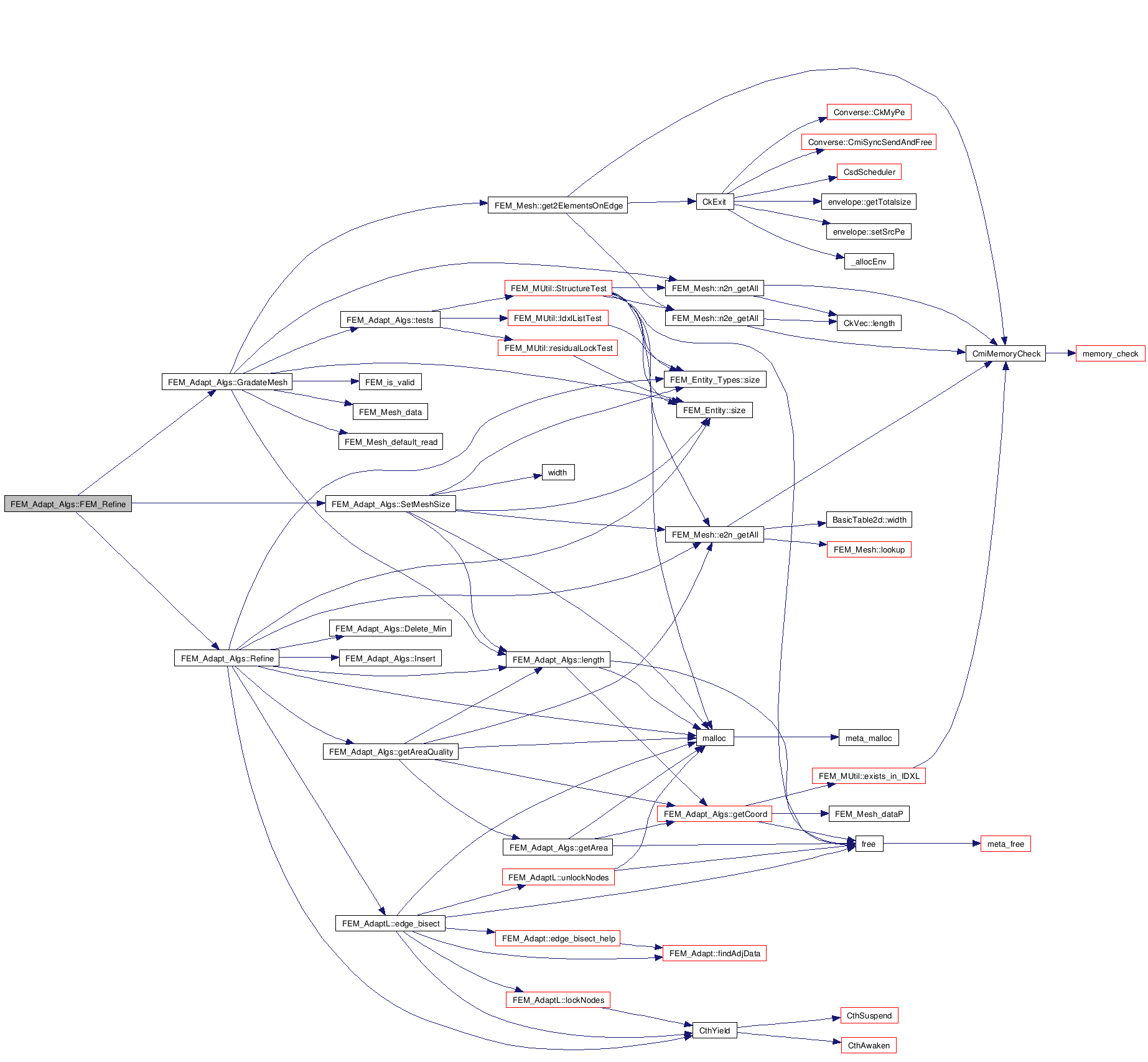

Perform coarsening on a mesh.
Perform coarsening on a mesh. Tries to maintain/improve element quality as specified by a quality measure qm; if method = 0, coarsen areas with size smaller than factor up to factor if method = 1, coarsen elements up to sizes specified in sizes array Negative entries in size array indicate no coarsening.
Tries to maintain/improve element quality as specified by a quality measure qm; if method = 0, coarsen areas with size smaller than factor up to factor if method = 1, coarsen elements up to sizes specified in sizes array Negative entries in size array indicate no coarsening.
Definition at line 137 of file fem_adapt_algs.C.
References Coarsen(), GradateMesh(), and SetMeshSize().
Referenced by FEM_ADAPT_Coarsen().


Perform refinement/coarsening on a mesh.
Performs a sequence of refinements or coarsening as is needed to achieve the target areas for elements.
Same as above
Definition at line 30 of file fem_adapt_algs.C.
References Coarsen(), GradateMesh(), Refine(), and SetMeshSize().
Referenced by FEM_ADAPT_AdaptMesh().
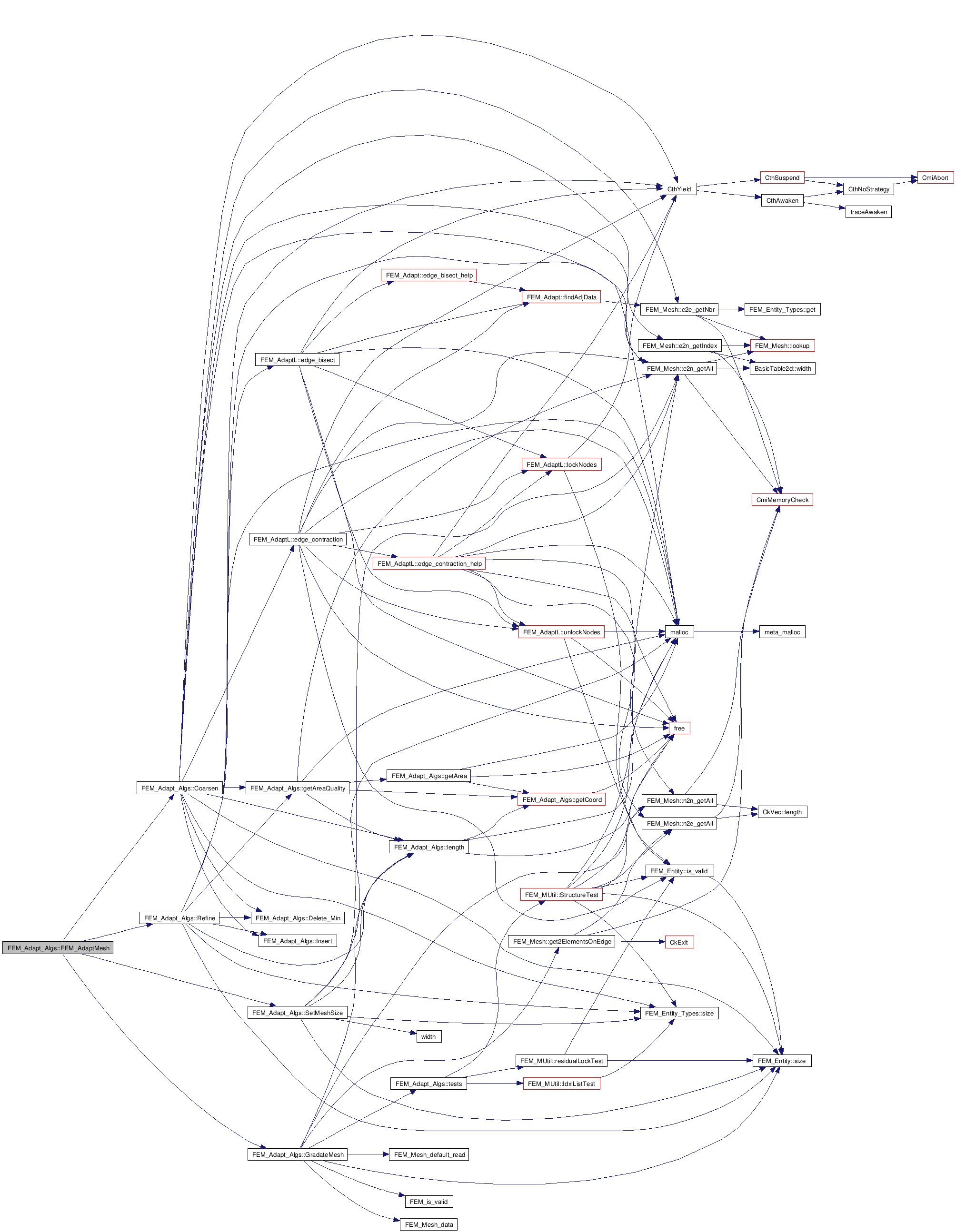

Smooth the mesh using method according to some quality measure qm.
Definition at line 255 of file fem_adapt_algs.C.
Repair the mesh according to some quality measure qm.
FEM_Mesh_smooth Inputs : meshP - a pointer to the FEM_Mesh object to smooth : nodes - an array of local node numbers to be smoothed.
Send NULL pointer to smooth all nodes. : nNodes - the size of the nodes array : attrNo - the attribute number where the coords are registered Shifts nodes around to improve mesh quality. FEM_BOUNDARY attribute and interpolator function must be registered by user to maintain boundary information.
Definition at line 1015 of file fem_adapt_algs.C.
References coords, FEM_is_valid(), FEM_Mesh_data(), FEM_Mesh_default_read(), FEM_Mesh_get_length(), FEM_set_entity_coord2(), FEM_Update_ghost_field(), idx, mesh, FEM_Mesh::n2n_getAll(), vector2d::x, and vector2d::y.

| void FEM_Adapt_Algs::FEM_Repair | ( | int | qm | ) |
Elements with a bad quality metric are either flipped or coarsened to newer elements which are of better quality.
Definition at line 261 of file fem_adapt_algs.C.
Remesh entire mesh.
Remesh entire mesh according to quality measure qm if method = 0, set entire mesh size to factor if method = 1, keep regional mesh sizes, and scale by factor if method = 2, uses sizes to size mesh by regions.
Remesh entire mesh according to quality measure qm if method = 0, set entire mesh size to factor if method = 1, keep regional mesh sizes, and scale by factor if method = 2, uses sizes to size mesh by regions
Definition at line 269 of file fem_adapt_algs.C.
| void FEM_Adapt_Algs::SetReferenceMesh | ( | ) |
Set sizes on mesh elements based on their average edge length.
For each element, set its size to its average edge length.
Definition at line 337 of file fem_adapt_algs.C.
References FEM_Mesh::e2n_getAll(), FEM_Mesh::elem, free(), length(), malloc(), numElements, FEM_Entity_Types< T >::size(), theMesh, and width().
Referenced by FEM_ADAPT_SetReferenceMesh().
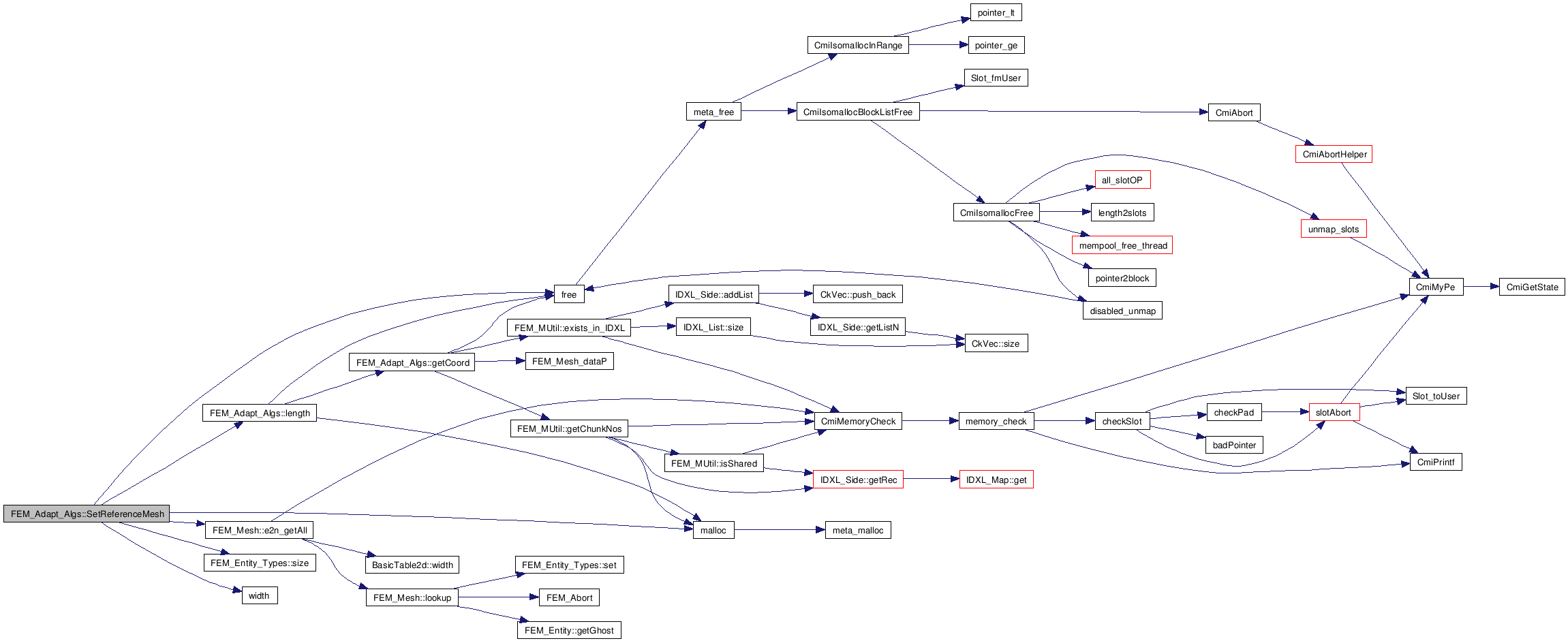

| void FEM_Adapt_Algs::GradateMesh | ( | double | smoothness | ) |
Adjust sizes on mesh elements to avoid sharp discontinuities.
Resize mesh elements to avoid jumps in element size Algorithm based on h-shock correction, described in Mesh Gradation Control, Borouchaki et al IJNME43 1998 www.ann.jussieu.fr/~frey/publications/ijnme4398.pdf.
Definition at line 359 of file fem_adapt_algs.C.
References beta, e1, FEM_Mesh::elem, FEM_is_valid(), FEM_Mesh_data(), FEM_Mesh_default_read(), FEM_Mesh::get2ElementsOnEdge(), length(), FEM_Mesh::n2n_getAll(), nnodes, FEM_Mesh::node, FEM_Entity::size(), tests(), and theMesh.
Referenced by FEM_ADAPT_GradateMesh(), FEM_AdaptMesh(), FEM_Coarsen(), and FEM_Refine().


Performs refinement; returns number of modifications.
The actual refine in the previous operation.
Definition at line 54 of file fem_adapt_algs.C.
References CthYield(), Delete_Min(), FEM_Mesh::e2n_getAll(), FEM_AdaptL::edge_bisect(), FEM_Mesh::elem, FEM_Adapt_Algs::elemHeap::elID, getAreaQuality(), Insert(), length(), malloc(), n1, n2, FEM_Mesh::node, numElements, numNodes, refineElements, refineHeapSize, refineStack, refineTop, FEM_Entity_Types< T >::size(), FEM_Entity::size(), theAdaptor, and theMesh.
Referenced by FEM_AdaptMesh(), and FEM_Refine().
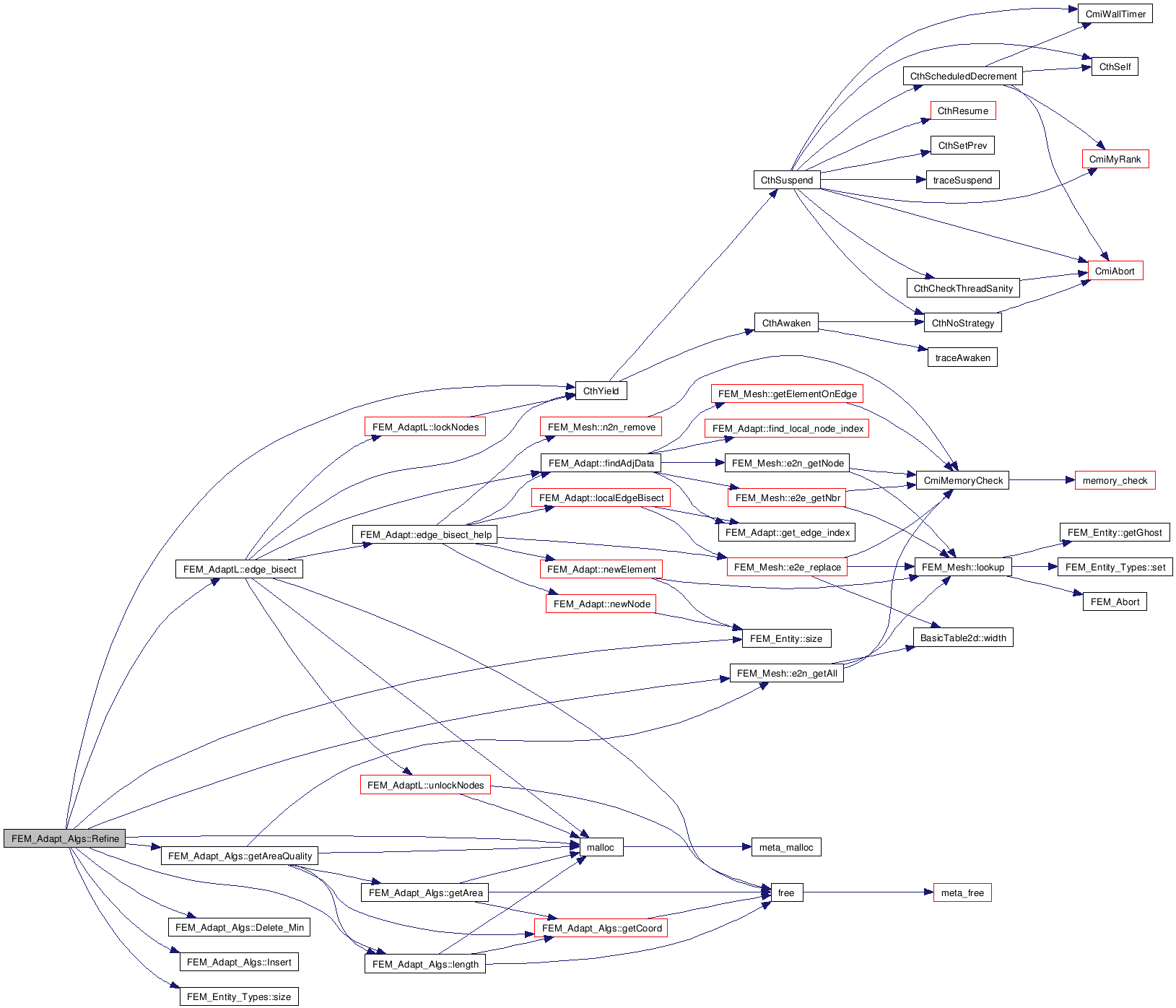

Performs coarsening; returns number of modifications.
The actual coarsen in the previous operation.
Definition at line 147 of file fem_adapt_algs.C.
References coarsenElements, coarsenHeapSize, CthYield(), Delete_Min(), FEM_Mesh::e2e_getNbr(), FEM_Mesh::e2n_getAll(), FEM_Mesh::e2n_getIndex(), FEM_AdaptL::edge_contraction(), FEM_Mesh::elem, FEM_Adapt_Algs::elemHeap::elID, getAreaQuality(), Insert(), FEM_Adapt_Algs::elemHeap::len, length(), malloc(), n1, n2, FEM_Mesh::node, numElements, numNodes, FEM_Entity_Types< T >::size(), FEM_Entity::size(), theAdaptor, and theMesh.
Referenced by FEM_AdaptMesh(), and FEM_Coarsen().


| void FEM_Adapt_Algs::SetMeshSize | ( | int | method, | |
| double | factor, | |||
| double * | sizes | |||
| ) | [private] |
Set sizes on elements throughout the mesh; note: size is edge length.
Definition at line 276 of file fem_adapt_algs.C.
References dim, FEM_Mesh::e2n_getAll(), FEM_Mesh::elem, length(), malloc(), FEM_Mesh::node, numElements, numNodes, FEM_Entity_Types< T >::size(), FEM_Entity::size(), theMesh, and width().
Referenced by FEM_AdaptMesh(), FEM_Coarsen(), and FEM_Refine().


Insert element to be refined/coarsened.
Insert this element to the refine or coarsen heap.
Definition at line 912 of file fem_adapt_algs.C.
References coarsenElements, coarsenHeapSize, FEM_Adapt_Algs::elemHeap::elID, FEM_Adapt_Algs::elemHeap::len, refineElements, and refineHeapSize.
Referenced by Coarsen(), and Refine().

Get next element to be refined/coarsened.
Removes and returns the minimum element from the refine/coarsen heap.
Definition at line 938 of file fem_adapt_algs.C.
References coarsenElements, coarsenHeapSize, FEM_Adapt_Algs::elemHeap::elID, FEM_Adapt_Algs::elemHeap::len, len, refineElements, and refineHeapSize.
Referenced by Coarsen(), and Refine().

Initiate instance of Longest Edge Bisection on an element.
Initiate instance of Longest Edge Bisection on element e.
Initiate instance of Longest Edge Bisection on element e. Propagates throughout the mesh to maintain the requirement that only longest edges are bisected; returns 1 if successful, 0 if not
Propagates throughout the mesh to maintain the requirement that only longest edges are bisected; returns the new node index that it created Given an element e, if e's longest edge f is also the longest edge of e's neighbor across f, g, split f by adding a new node in the center of f, and splitting both e and g into two elements. If g does not have f as it's longest edge, recursively call refine_element_leb on g, and start over.
Definition at line 649 of file fem_adapt_algs.C.
References FEM_Mesh::e2e_getNbr(), FEM_Mesh::e2n_getAll(), FEM_Adapt::e2n_getNot(), FEM_AdaptL::edge_bisect(), FEM_Adapt::findElementWithNodes(), free(), femMeshModify::getfmUtil(), FEM_Adapt::getGhostElementIdxl(), FEM_Adapt::getGhostNodeIdxl(), FEM_MUtil::getIdx(), FEM_MUtil::getRemoteIdx(), FEM_Adapt::getSharedNodeIdxl(), length(), malloc(), meshMod, refine_flip_element_leb(), theAdaptor, theMesh, and theMod.
Referenced by refine_flip_element_leb(), and simple_refine().


Continue longest edge bisection on element 'e', then flip edge (n1,n2); If the length of the new edge (p, newnode) is greater than 'le' (longest edge), recursively call this function on (newElem, p, n1, newNode, le).
Definition at line 713 of file fem_adapt_algs.C.
References FEM_AdaptL::edge_flip(), FEM_Adapt::findElementWithNodes(), femMeshModify::getfmUtil(), FEM_MUtil::getIdx(), length(), refine_element_leb(), theAdaptor, and theMod.
Referenced by refine_element_leb(), and femMeshModify::refine_flip_element_leb().
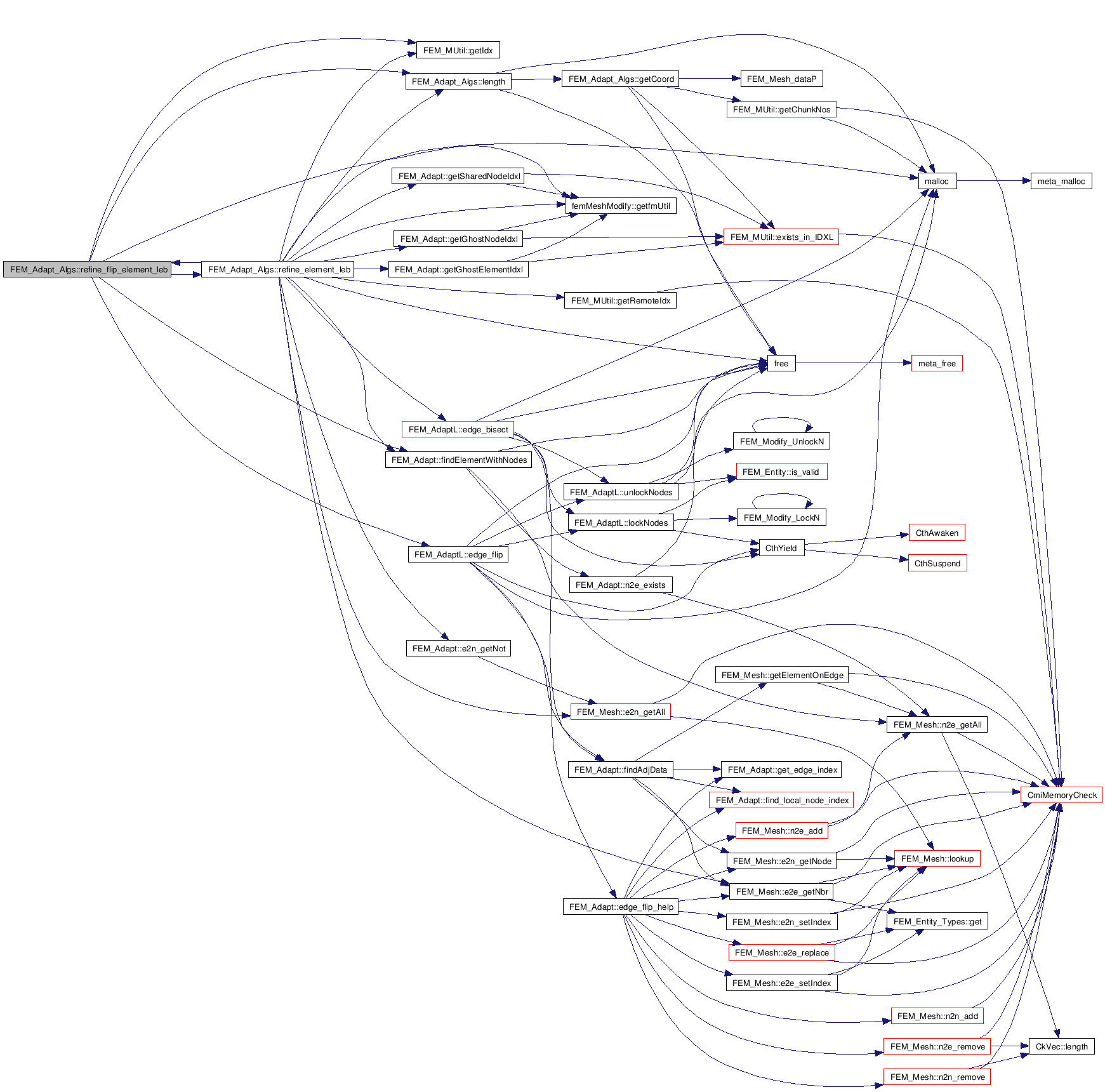

| int FEM_Adapt_Algs::simple_refine | ( | double | targetA, | |
| double | xmin = 0.0, |
|||
| double | ymin = 0.0, |
|||
| double | xmax = 1.0, |
|||
| double | ymax = 1.0 | |||
| ) |
The region is defined by (xmax, xmin, ymax, ymin) and the target area is given by targetA.
Definition at line 489 of file fem_adapt_algs.C.
References FEM_Mesh::e2n_getAll(), FEM_Mesh::elem, free(), getArea(), getCoord(), malloc(), refine_element_leb(), FEM_Entity_Types< T >::size(), PUP::t, and theMesh.
Referenced by FEM_ADAPT_SimpleRefineMesh().


| int FEM_Adapt_Algs::simple_coarsen | ( | double | targetA, | |
| double | xmin = 0.0, |
|||
| double | ymin = 0.0, |
|||
| double | xmax = 1.0, |
|||
| double | ymax = 1.0 | |||
| ) |
The region is defined by (xmax, xmin, ymax, ymin) and the target area is given by targetA.
Definition at line 556 of file fem_adapt_algs.C.
References FEM_Mesh::e2n_getAll(), FEM_AdaptL::edge_contraction(), FEM_Mesh::elem, free(), getArea(), getCoord(), getShortestEdge(), malloc(), FEM_Entity_Types< T >::size(), PUP::t, theAdaptor, and theMesh.
Referenced by FEM_ADAPT_SimpleCoarsenMesh().


Definition at line 729 of file fem_adapt_algs.C.
References dim, free(), getCoord(), and malloc().
Referenced by Coarsen(), controlQualityC(), controlQualityR(), ensureQuality(), flipOrBisect(), getAreaQuality(), getShortestEdge(), GradateMesh(), Refine(), refine_element_leb(), refine_flip_element_leb(), SetMeshSize(), and SetReferenceMesh().


Definition at line 755 of file fem_adapt_algs.C.
References dim, free(), getCoord(), and malloc().
Referenced by FEM_MUtil::AreaTest(), controlQualityR(), getAreaQuality(), simple_coarsen(), and simple_refine().


| double FEM_Adapt_Algs::length | ( | double * | n1_coord, | |
| double * | n2_coord | |||
| ) |
| double FEM_Adapt_Algs::getArea | ( | double * | n1_coord, | |
| double * | n2_coord, | |||
| double * | n3_coord | |||
| ) |
Definition at line 849 of file fem_adapt_algs.C.
References IDXL_Share::chk, coord_attr, PUP::d, dim, FEM_MUtil::exists_in_IDXL(), FEM_Mesh_dataP(), femMeshModify::fmUtil, free(), FEM_MUtil::getChunkNos(), double2Msg::i, femMeshModify::idx, index, double2Msg::j, meshMod, theMesh, and theMod.
Referenced by controlQualityC(), controlQualityF(), controlQualityR(), didItFlip(), ensureQuality(), getArea(), getAreaQuality(), getShortestEdge(), getSignedArea(), length(), simple_coarsen(), and simple_refine().
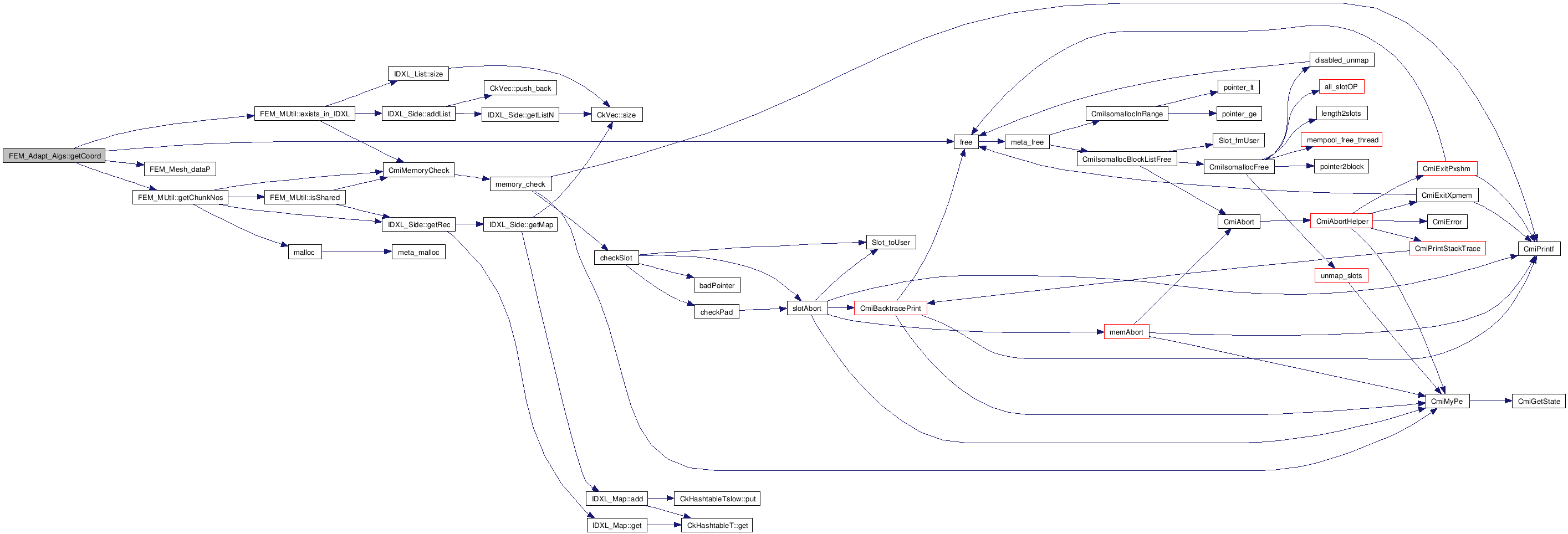

Definition at line 875 of file fem_adapt_algs.C.
References dim, free(), getCoord(), length(), and malloc().
Referenced by simple_coarsen().


| double FEM_Adapt_Algs::getAreaQuality | ( | int | elem | ) |
The quality metric is proportional to the area of the triangle upon the sum of squares of the lengths of each of the 3 sides.
Definition at line 981 of file fem_adapt_algs.C.
References dim, FEM_Mesh::e2n_getAll(), getArea(), getCoord(), len, length(), malloc(), n, and theMesh.
Referenced by Coarsen(), and Refine().


Definition at line 802 of file fem_adapt_algs.C.
References dim, free(), getCoord(), getSignedArea(), and malloc().
Referenced by FEM_AdaptL::edge_contraction_help().


| bool FEM_Adapt_Algs::didItFlip | ( | double * | n1_coord, | |
| double * | n2_coord, | |||
| double * | n3_coord, | |||
| double * | n4_coord | |||
| ) |
Definition at line 827 of file fem_adapt_algs.C.
References getSignedArea().

| double FEM_Adapt_Algs::getSignedArea | ( | double * | n1_coord, | |
| double * | n2_coord, | |||
| double * | n3_coord | |||
| ) |
Definition at line 836 of file fem_adapt_algs.C.
Referenced by controlQualityC(), didItFlip(), ensureQuality(), and getSignedArea().

| void FEM_Adapt_Algs::tests | ( | void | ) |
Definition at line 628 of file fem_adapt_algs.C.
References femMeshModify::fmUtil, FEM_MUtil::IdxlListTest(), FEM_MUtil::residualLockTest(), FEM_MUtil::StructureTest(), theMesh, and theMod.
Referenced by FEM_ADAPT_TestMesh(), and GradateMesh().


| void FEM_Adapt_Algs::FEM_AdaptAlgsSetMesh | ( | FEM_Mesh * | m | ) | [inline] |
Initialize FEM_Adapt with the FEM_Mesh object.
Definition at line 87 of file ParFUM_Adapt_Algs.h.
References theMesh.
Referenced by femMeshModify::setPointersAfterMigrate().

Initialize the coord_attr and boundary attr and number of dimensions for this mesh.
Definition at line 89 of file ParFUM_Adapt_Algs.h.
References bc_attr, coord_attr, and dim.
| void FEM_Adapt_Algs::pup | ( | PUP::er & | p | ) | [inline] |
pup for this object
Definition at line 97 of file ParFUM_Adapt_Algs.h.
References bc_attr, coord_attr, and dim.
Referenced by femMeshModify::pup().

Perform refinements on a mesh.
Perform coarsening on a mesh.
Perform refinement/coarsening on a mesh.
Smooth the mesh using method according to some quality measure qm.
Repair the mesh according to some quality measure qm.
| void FEM_Adapt_Algs::FEM_Repair | ( | int | qm | ) |
Repair the bad quality elements of a mesh.
Remesh entire mesh.
| void FEM_Adapt_Algs::SetReferenceMesh | ( | ) |
| void FEM_Adapt_Algs::GradateMesh | ( | double | smoothness | ) |
Adjust sizes on mesh elements to avoid sharp discontinuities.
Performs refinement; returns number of modifications.
Performs coarsening; returns number of modifications.
| void FEM_Adapt_Algs::SetMeshSize | ( | int | method, | |
| double | factor, | |||
| double * | sizes | |||
| ) | [private] |
Insert element to be refined/coarsened.
The propagating function for Longest Edge Bisection.
| int FEM_Adapt_Algs::simple_refine | ( | double | targetA, | |
| double | xmin = 0.0, |
|||
| double | ymin = 0.0, |
|||
| double | xmax = 1.0, |
|||
| double | ymax = 1.0 | |||
| ) |
A simple refine algorithm that refines all elements in a region to areas larger than targetA.
| int FEM_Adapt_Algs::simple_coarsen | ( | double | targetA, | |
| double | xmin = 0.0, |
|||
| double | ymin = 0.0, |
|||
| double | xmax = 1.0, |
|||
| double | ymax = 1.0 | |||
| ) |
A simple coarsen algorithm that coarsen all elements in a region to areas smaller than targetA.
Returns the length of the edge formed by nodes n1, n2.
| double FEM_Adapt_Algs::length | ( | double * | n1_coord, | |
| double * | n2_coord | |||
| ) |
Returns the length between these two points.
Returns the area of the triangle formed by n1, n2 aand n3.
| double FEM_Adapt_Algs::getArea | ( | double * | n1_coord, | |
| double * | n2_coord, | |||
| double * | n3_coord | |||
| ) |
Returns the area between these three points.
Returns the signed area of the triangle formed by the nodes in that order.
Definition at line 1259 of file adapt_algs.C.
References getCoord(), and getSignedArea().

| double FEM_Adapt_Algs::getSignedArea | ( | double * | n1_coord, | |
| double * | n2_coord, | |||
| double * | n3_coord | |||
| ) |
Returns the signed area of the triangle formed by the point coordinates in that order.
Populates crds with the coordinates of the node n1.
Retuns the shortest edge for the triangle formed by n1, n2, n3.
Ensure the quality of the triangle formed by these three nodes.
The quality metric used is the maxEdgeLength / shortestAltitude of the triangle If this metric is less than 100 and the area is greater than sliverArea, the quality is supposed to be good.
Definition at line 1373 of file adapt_algs.C.
References getCoord(), getSignedArea(), length(), and min().
Referenced by FEM_add_element_local().


Verify if flip(n1,n2) will create bad quality elements.
Verify the quality of the two new elements that will be created by flip.
Definition at line 1396 of file adapt_algs.C.
References controlQualityC(), flag, and getCoord().

Verify if bisect(n1,n2) will create bad quality elements.
Verify the quality of the four new elements that will be created by flip.
Definition at line 1412 of file adapt_algs.C.
References controlQualityR(), flag, femMeshModify::fmAdaptAlgs, getCoord(), and theMod.
Referenced by controlQualityR().


| bool FEM_Adapt_Algs::controlQualityR | ( | double * | n1_coord, | |
| double * | n2_coord, | |||
| double * | n3_coord | |||
| ) |
Same as above; instead of node indices, it takes point coordinates as input.
Definition at line 1430 of file adapt_algs.C.
References getArea(), and length().

Returns true if the quality will become bad if element (n1,n2,n3) changes to (n1,n2,n4).
Computes the longestLength, shotestLength, shortestAltitude, and other quality metrics for the new element (n1,n2,n4) If the new element forms a sliver or bad quality, return true.
Definition at line 1450 of file adapt_algs.C.
References getCoord().
Referenced by controlQualityF().


| bool FEM_Adapt_Algs::controlQualityC | ( | double * | n1_coord, | |
| double * | n2_coord, | |||
| double * | n3_coord, | |||
| double * | n4_coord | |||
| ) |
same as above only takes in point coordinates instead of node indices
Definition at line 1459 of file adapt_algs.C.
References getSignedArea(), length(), and min().

Decide based on quality metrics if a flip or bisect is good for this element.
Used from FEM_Repair, when poor quality elements are encountered, depending on their maxEdgeLength, it could be better to flip it or bisect it to get better quality elements.
Returns true if it should flip.
Definition at line 1492 of file adapt_algs.C.
References FEM_Mesh::e2e_getNbr(), FEM_Mesh::e2n_getAll(), length(), and theMesh.

| void FEM_Adapt_Algs::tests | ( | bool | b = true |
) |
A series of tests to maintain validity of mesh structure, area, IDXL lists, etc.
Definition at line 1515 of file adapt_algs.C.
References FEM_MUtil::AreaTest(), PUP::b, femMeshModify::fmUtil, FEM_MUtil::IdxlListTest(), FEM_MUtil::residualLockTest(), FEM_MUtil::StructureTest(), theMesh, and theMod.
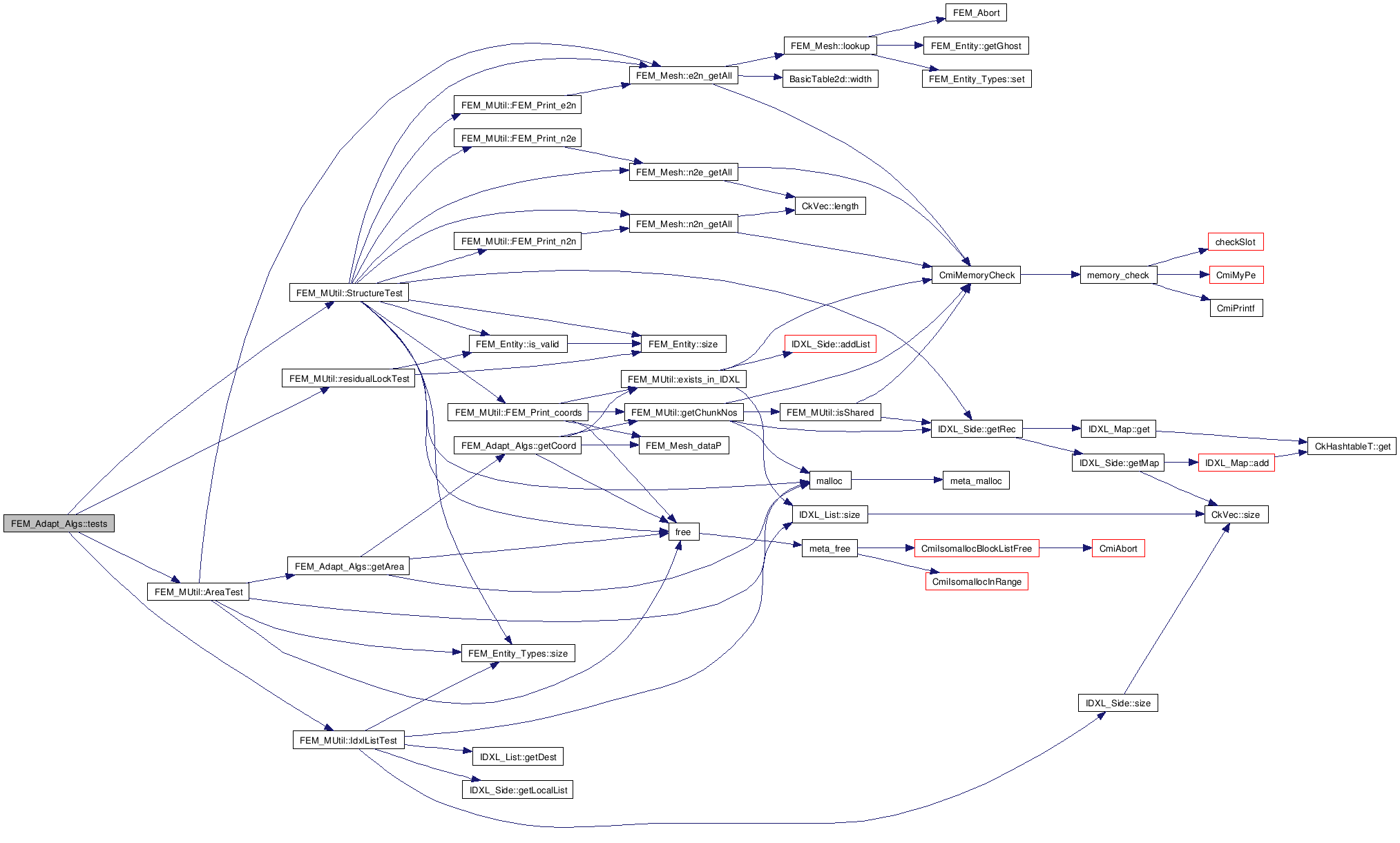
FEM_AdaptL [friend] |
Definition at line 35 of file fem_adapt_algs.h.
FEM_Adapt [friend] |
Definition at line 36 of file fem_adapt_algs.h.
femMeshModify [friend] |
Definition at line 37 of file fem_adapt_algs.h.
FEM_Interpolate [friend] |
Definition at line 38 of file fem_adapt_algs.h.
FEM_MUtil [friend] |
Definition at line 39 of file fem_adapt_algs.h.
attribute index for coordinates
Definition at line 42 of file fem_adapt_algs.h.
Referenced by FEM_MUtil::addGhostElementRemote(), FEM_AdaptL::edge_contraction_help(), FEM_Adapt_Algs_Init(), FEM_Ghost_Essential_attributes(), FEM_Interpolate::FEM_InterpolateCopyAttributes(), FEM_Interpolate::FEM_InterpolateNodeOnEdge(), FEM_MUtil::FEM_Print_coords(), getCoord(), femMeshModify::getRemoteCoord(), pup(), and femMeshModify::updateNodeAttrs().
attribute index for boundaries
Definition at line 43 of file fem_adapt_algs.h.
Referenced by FEM_Adapt_Algs_Init(), and pup().
FEM_Mesh* FEM_Adapt_Algs::theMesh [protected] |
Definition at line 46 of file fem_adapt_algs.h.
Referenced by Coarsen(), FEM_Adapt_Algs(), FEM_AdaptAlgsSetMesh(), flipOrBisect(), getAreaQuality(), getCoord(), GradateMesh(), Refine(), refine_element_leb(), SetMeshSize(), SetReferenceMesh(), simple_coarsen(), simple_refine(), and tests().
femMeshModify* FEM_Adapt_Algs::theMod [protected] |
Definition at line 47 of file fem_adapt_algs.h.
Referenced by controlQualityR(), FEM_Adapt_Algs(), getCoord(), refine_element_leb(), refine_flip_element_leb(), and tests().
FEM_AdaptL* FEM_Adapt_Algs::theAdaptor [protected] |
Definition at line 49 of file fem_adapt_algs.h.
Referenced by Coarsen(), FEM_Adapt_Algs(), Refine(), refine_element_leb(), refine_flip_element_leb(), and simple_coarsen().
int FEM_Adapt_Algs::numNodes [protected] |
Number of nodes on this chunk.
Definition at line 50 of file fem_adapt_algs.h.
Referenced by Coarsen(), ParFUMShadowArray::collectLocalNodes(), Refine(), and SetMeshSize().
int FEM_Adapt_Algs::numElements [protected] |
Number of elements on this chunk.
Definition at line 50 of file fem_adapt_algs.h.
Referenced by Coarsen(), Refine(), SetMeshSize(), and SetReferenceMesh().
int FEM_Adapt_Algs::dim [protected] |
The number of dimensions of this mesh (adaptivity works only for 2D).
Definition at line 50 of file fem_adapt_algs.h.
Referenced by didItFlip(), FEM_Adapt_Algs(), FEM_Adapt_Algs_Init(), getArea(), getAreaQuality(), getCoord(), getShortestEdge(), length(), pup(), and SetMeshSize().
elemHeap* FEM_Adapt_Algs::coarsenElements [protected] |
Definition at line 56 of file fem_adapt_algs.h.
Referenced by Coarsen(), Delete_Min(), and Insert().
elemHeap* FEM_Adapt_Algs::refineElements [protected] |
elemHeap* FEM_Adapt_Algs::refineStack [protected] |
int FEM_Adapt_Algs::refineTop [protected] |
The number of entries in refinestack.
Definition at line 59 of file fem_adapt_algs.h.
Referenced by Refine().
int FEM_Adapt_Algs::refineHeapSize [protected] |
The number of entries in the refine heap.
Definition at line 59 of file fem_adapt_algs.h.
Referenced by Delete_Min(), Insert(), and Refine().
int FEM_Adapt_Algs::coarsenHeapSize [protected] |
The number of entries in the coarsen heap.
Definition at line 59 of file fem_adapt_algs.h.
Referenced by Coarsen(), Delete_Min(), and Insert().
FEM_Mesh* FEM_Adapt_Algs::theMesh [protected] |
femMeshModify* FEM_Adapt_Algs::theMod [protected] |
cross-pointer to the femMeshModify object on this chunk
Definition at line 46 of file ParFUM_Adapt_Algs.h.
FEM_AdaptL* FEM_Adapt_Algs::theAdaptor [protected] |
cross-pointer to the FEM_AdaptL object for this chunk
Definition at line 48 of file ParFUM_Adapt_Algs.h.
elemHeap* FEM_Adapt_Algs::coarsenElements [protected] |
A heap pointer created while coarsening (to order from smallest to largest length).
Definition at line 61 of file ParFUM_Adapt_Algs.h.
elemHeap* FEM_Adapt_Algs::refineElements [protected] |
A heap pointer created while refining (to order from largest to smallest length).
Definition at line 63 of file ParFUM_Adapt_Algs.h.
elemHeap* FEM_Adapt_Algs::refineStack [protected] |
int* FEM_Adapt_Algs::elemConn [protected] |
Used for populating the e2n adjacency connectivity for an element (avoids multiple memory allocations).
Definition at line 73 of file ParFUM_Adapt_Algs.h.
double* FEM_Adapt_Algs::coordsn1 [protected] |
Coordinates of the three nodes which form the e2n of an element (avoids multiple memory allocations).
Definition at line 75 of file ParFUM_Adapt_Algs.h.
double * FEM_Adapt_Algs::coordsn2 [protected] |
Definition at line 75 of file ParFUM_Adapt_Algs.h.
double * FEM_Adapt_Algs::coordsn3 [protected] |
Definition at line 75 of file ParFUM_Adapt_Algs.h.
 1.5.5
1.5.5